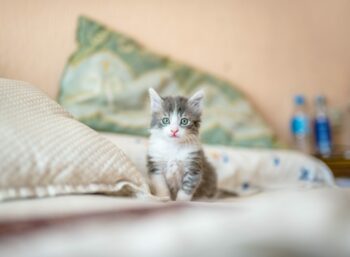There’s one member of the household you don’t want to encourage to “think outside of the box” — your resident cat.
In the wild, felines naturally do their business in soft soil or sand because they instinctually bury their waste. As cats became domestic animals, people simulated this behavior by providing pets with a litter box — nowadays a plastic box filled with some form of cat litter. Most cats take to the litter box like a fish takes to water. But, in some households, a cat may eschew its designated toilet and instead start soiling a carpet, the couch or other area.
It’s a feline behavior that most pet owners need to understand and address immediately. Stains and odors in these locations may draw the cat back again and again to the same spot.
Pet Owners Turn Pet Detectives
Dr. Katherine Miller, senior behavioral counselor of the American Society for the Prevention of Cruelty to Animals, goes through a series of questions with pet owners to root out the cause of a litter-box problem. First, she rules out a medical condition — such as a urinary tract infection or diabetes, the latter of which would cause the cat to drink excessively and often urinate. Then she goes down a checklist. “I ask when the problem started whether there were changes in the household, including the addition of another pet or person, the loss of a person or the change of family or school schedules,” Miller says. “Then I ask where the soiling is happening. Cats that are anxious and have litter box problems use places in the household that are important to them — their own bed or a human bed or couch. Or, if they are frightened, they may choose the back of a closet, or a corner in back of furniture.”
Discourage Returns to the Scene of the Crime
No matter why the soiling is occurring, it is in your best interest to clean the area with an enzymatic cleanser that will eat up organic molecules and remove the source of the odor. Household cleaners, in general, may leave an odor that a cat can still detect and that will encourage the cat to continue soiling the area. The ASPCA points out ammonia-based cleaners are particularly poor choices, because urine contains some ammonia and that could encourage the cat to repeat his or her performance. Miller also recommends the use of sprays or diffusers that reproduce some of the properties of cat facial pheromones. One such product is Feliway Cat Pheromone Spray. When your cat feels safe, it rubs its head against furniture, legs or doorways, leaving markings. “This mimics that odor and can help reduce tension, anxiety and stress and lead to a more relaxing environment for the cat,” Miller says.
Litter Box Reassessment
The litter box itself may be the turn-off. Dr. Christianne Schelling, a veterinarian in Three Rivers, Calif., who maintains a not-for-profit educational web site The Litter Box, recommends one litter box per cat in the household, plus an extra box. “Some cats prefer to urinate in one and defecate in another,” Schelling says. “You have to figure out what is right for each individual cat.” Schelling also recommends these steps:
- Figure out if the box is big enough Cats like to get in and be able to turn around. If a commercial box isn’t large enough, consider turning an under-the-bed sweater bin into a litter box.
- Make sure there’s enough litter Cats like to dig. Don’t skimp on litter.
- Reconsider the plastic liner While liners make the cleanup easier for you, the cat may not like the crinkling noise or the slippery feel.
- Type of litter is key Cats may be giving a thumbs-down on pelletized or clay litter. Schelling says most cats prefer sand or clumping litter.
- Clean the box regularly Cats by nature are finicky. If there’s even one little mess in the box, they may not go back. Have a garbage pail right next to the litter box to make frequent cleanups easy.
- The jury is still out on automatic self-cleaning boxes Some cats love boxes that clean themselves. They hear the noise and hang around to watch it scoop. But to other cats, the whirring noise of the motor “scares the living daylights out of them,” Schelling says.
Kitty Litter “Boot Camp”
Some cats may need to be retrained to use the litter box. Miller suggests having the cat undergo “litter box boot camp” by confining them to one room with their litter box for a few days. The last thing any pet owner should do to a cat with a litter-box problem is to punish the cat. If you catch them in the act, pick them up and put them in the box. “If you find a mess after the fact, it’s already too late to do anything,” Miller says.







